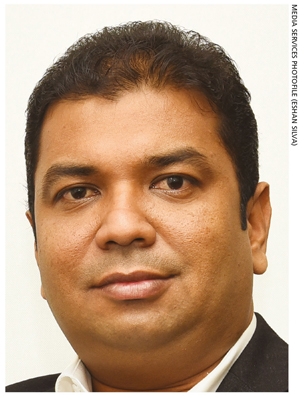MARKETING PROFESSION
Compiled by Lourdes Abeyeratne
MARKETING IN THE NEW AGE
Sasith Wadigasinghe delineates the evolving role of marketers in banking
Q: How do you view the role of marketing in the current banking landscape?
A: Over the next three to five years, the financial services industry and its systems will likely be subject to major structural and operational transformations. Some intrinsic relative advantages that banks rely on are eroding. These pressures have the potential to transform the sector and how traditional banking is conducted.
They’re also likely to affect current marketing models as banks shift to contract banking – i.e. partnerships with industry giants possessing large customer bases. Marketing plays a major role in leading this controversial transformation across a spectrum of stakeholders.
Marketers need to be equipped to manage and understand consumer psychology more than ever. Currently, we’re experiencing new dimensions of push and pull factors.
Instead of demand creation, marketers should focus on understanding demand as comparative coherence becomes more aggressive.

Q: And how is technology transforming marketing?
A: The ‘opti-channel’ marketing concept is proficient in communicating and supporting consumers’ buying processes through the best suited channel given the overall objectives beyond multi or omni-channel concepts.
The purpose is to maintain a seamless changeover between digital and physical delivery channels, as well as new age and traditional mass media communication channels for the best possible experience.
There’s an ongoing contraction of the usefulness of interruptive strategies especially in financial services since customers are bombarded with defectively targeted and poorly envisaged campaigns. As such, there’s an emerging need for optimistic and relevant interactive content marketing that can be delivered through a contextual approach.
Content marketing tactics should comprise interactive assessments, dynamic calculators, trending training, current affairs and insightful games to engage people through various means in sales processes. Some financial institutions are testing these tools, yet many are buried in a website or online design.
Q: Have data driven insights impacted the sector?
A: The significance of consumer insight and dynamic data mining will be more vital with Sri Lanka’s middle class boom.
In the past, most financial marketers indulged in more talk than action around big data as they were underpinned by a skills deficiency and marketing dollars. Now advanced analytics with new mechanisms and technologies for businesses of all sizes, as well as digital channels and the desire for personalised offers, make the investment in data analytics essential.
Insight driven marketing has been put to better use by most other sectors. Unfortunately, leveraging advanced analytics for such marketing ranks very low on financial priorities based on the local market context. This is because most marketers focus on the masses rather than potential niches.
Q: What are the foremost challenges facing marketers today?
A: Quantifying performance and proving results has been the key challenge for most financial services institutions. Validating ROI is more important than ever with marketing investments reducing across most organisations. Marketers must shift their spending to reflect this potential.
Over the last decade, there’s been a growing trend of young consumers who are comfortable with online services and mobile applications.
This in turn has driven the urge to invest in remote banking solutions. Switching to tech platforms reduces administration, infrastructure, and operational and maintenance costs – these are the stepping stones to the lean concept.
In turn, this increases banks’ profitability along with enhancing customer experiences and personalising service – all of which will assure reliability, improve security, extend flexibility and simplify functionality. In time, such solutions will be must-haves in every financial services institution.
Q: Finally, what is the long-term outlook for marketing in banking?
A: Customers expect transparency with tighter controls over financial information – so banks must expand their CRM efforts, not only by possessing a larger share of wallet but also amplifying personal associations in line with data analysis techniques. This will diversify traditional marketing but not eradicate it.
Banks will always exist as they serve the basic financial and economic needs of any country. Unlike other organisations, banks have a wide array of prospective areas that require concentrated marketing efforts in different forms. So one expects marketing to survive in the longer run but evolve dynamically.





